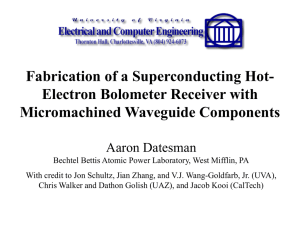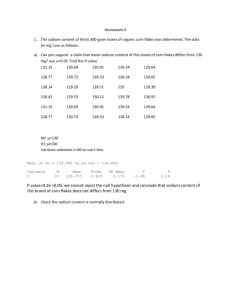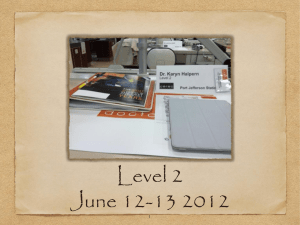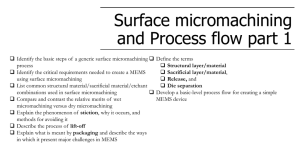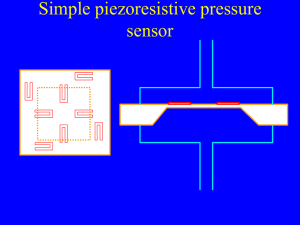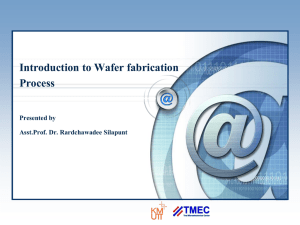IEE572-Design of Engineering Experiments Project Proposal
advertisement
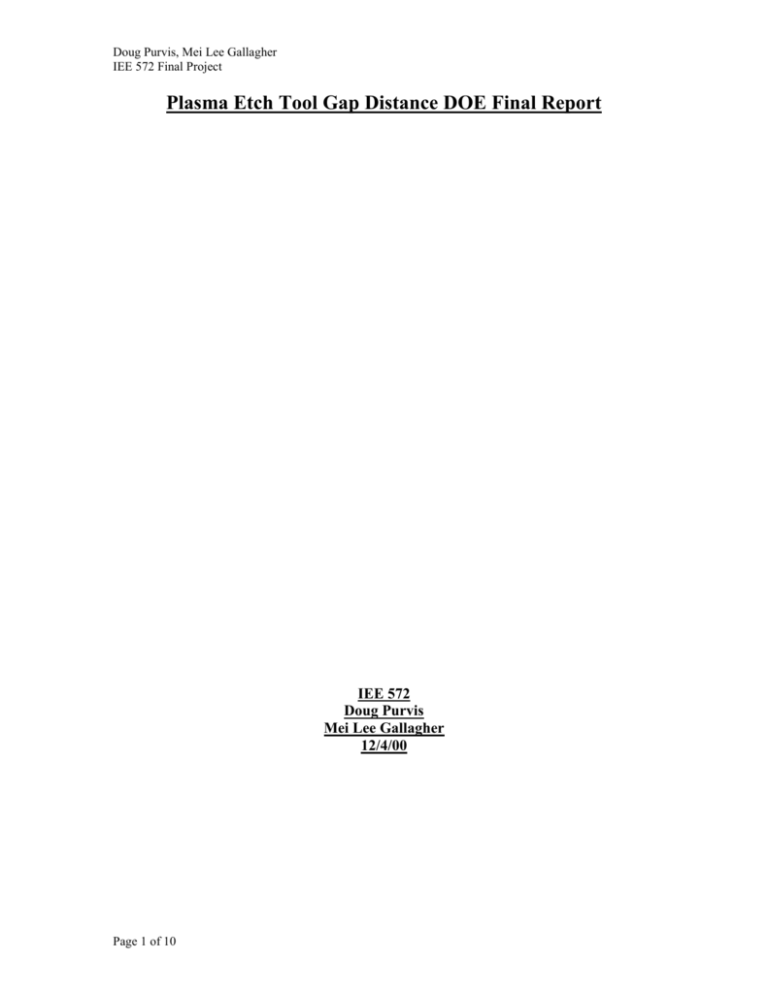
Doug Purvis, Mei Lee Gallagher IEE 572 Final Project Plasma Etch Tool Gap Distance DOE Final Report IEE 572 Doug Purvis Mei Lee Gallagher 12/4/00 Page 1 of 10 Doug Purvis, Mei Lee Gallagher IEE 572 Final Project Protocol Purpose: To establish new Power, Pressure, and Gas Ratio setpoints that are acceptable for use with a new gap setting of 1.2cm. This will characterize a more robust process for the Lam 4526 Oxide etch system that will decrease tool maintenance downtime. The current process is very sensitive to minimal variation in the gap setting, which can occur over time in a high volume semiconductor manufacturing environment. Background: The experimentation for this project will use a Lam Research 4526 reactive ion plasma etch tool at the Motorola MOS6 wafer fab in Mesa, AZ. The 4526 uses CF4 and CHF3 as the etching gasses, and radio frequency (RF) power to drive the plasma. The etching chamber is configured for six-inch diameter silicon wafers, and is a single wafer etcher (one wafer per run). Gap Figure 1: Schematic of the Lam 4526 RIE Etch chamber Previously, experiments have been run varying the gap (the distance in cm between the upper and lower electrodes in the chamber) to determine a process setting that is more stable than the current process. The current process is running with a gap of 1.08 cm, and is very sensitive to changes in the gap due to electrode wear and lowers the availability of Page 2 of 10 Doug Purvis, Mei Lee Gallagher IEE 572 Final Project the tool due to maintenance to correct the problem. The new process gap set point is 1.2 cm, and is much more stable than the current process (see figure 2). To maintain the etch rate of the current process, so that throughput is not sacrificed, the pressure set point must be increased in the new process to 385 mT. In order to implement the new process, we must examine possible effects of the main process controls: power, pressure, and gas flow. This will determine whether the process is robust enough for manufacturing use, and if the process is operating near any “cliffs” where the output will be greatly affected with a small change in the input. ETCH RATE vs. GAP AND PRESSURE SET POINT ALL DATA FROM 4508 6000 E/R @ 250 #1 E/R @ 250 #2 E/R @ 250 #3 E/R @ 370 #1 5900 ETCH RATE (Ang/min) 5800 5700 5600 GAP CENTERED AT 1.2 cm (+/- 50 COUNTS) SAME WAFER AREA PRESSURE AS BEFORE LESS SENSITIVE TO GAP OFFSET PROCEDURES 5500 5400 5300 WHERE WE ARE CURRENTLY OPERATING 5200 5100 5000 1.000 1.050 1.100 1.150 1.200 ABSOLUTE GAP VALUE Figure 2: Etch Rate vs. Gap for current and optimized process Page 3 of 10 1.250 1.300 Doug Purvis, Mei Lee Gallagher IEE 572 Final Project Factors, Levels and Ranges: The factors for this characterization are the three main factors that affect any RIE plasma etch: power, chamber pressure, and etch gas (CF4, CHF3) flows. All three variables are easily controlled with recipe settings on the machine. The gas flows will be set as a gas ratio so that the total gas flow in the chamber is held constant. This will keep the plasma pressure constant, so that variable won’t further confound the results. In an attempt to simulate extreme machine drift each factor will be varied +/- 20% from the recipe set points. The ranges will be as follows: Table 1. Factor Ranges Low Standard High Power 600 750 900 Pressure 300 385 470 CF4:CHF3 1.8 2.2 2.6 Response Variables: There is a total of 5 responses that will be studied in this report. The response variables for the experiment are based on the etch rates of films that are usually being etched (oxide), or blocking the etch (polysilicon, photo resist). The ratio of the etch rate for the film being etched to the etch rate of the film blocking the etch is called the selectivity. The outputs for this experiment are: Oxide Etch Rate, Polysilicon Etch Rate, Photo Resist Etch Rate, Oxide:Polysilicon selectivity, and Oxide:Photo Resist selectivity. All etch rate data will be determined by measuring oxide, polysilicon, and photo resist wafers before and after etch. The measurement tool is a Leitz system, which is the standard tool used for etch rate quals on the 4526’s. Analysis of Data: Statistical analysis will consist of ANOVA and residual outputs. The final model with the corresponding coefficients and R2 values will be presented. Page 4 of 10 Doug Purvis, Mei Lee Gallagher IEE 572 Final Project Experimental Design: The experiment is a 23 factorial design, with 3 factors: A = Power (W) B = Pressure (mT) C = Etch Gas Flow CH4: CH3 (unitless) The regression model is: Yn = X0 + X1A + X2B + X3C + i where Yn = the response (there are 5 responses being studied in this experiment) X0 = the intercept X1….X3 = the coefficients corresponding to each of the three factors A, B, and C i = the model error A total of 5 responses will be acquired by studying the low, high, and centerpoint values of the 3 factors. A total of 2 centerpoint experiments will be run. To minimize any potential block effects due to operator variability, two blocks will be run. This will give one block per operator. The randomized 10 runs as set-up by Design Expert are in Table 2 below. Table 2. Design Matrix Std 4 7 1 6 9 8 5 2 3 10 Run 1 2 3 4 5 6 7 8 9 10 Page 5 of 10 Block 1 1 1 1 1 2 2 2 2 2 Power (W) 900 600 600 900 750 900 600 900 600 750 Pressure (mT) 470 470 300 300 385 470 300 300 470 385 Gas Ratio 1.8 2.6 1.8 2.6 2.2 2.6 2.6 1.8 1.8 2.2 Oxide Etch Rate (A/min) Polysilicon Etch Rate (A/min) PhotoResist Etch Rate (A/min) Oxide Polysilicon Selectivity Oxide Photo Resisit Selectivity Doug Purvis, Mei Lee Gallagher IEE 572 Final Project Results The results are summarized in table 3 below. The data entry files into Design Expert for data analysis and response surface composite design analysis are included in the Appendix on the 2 pages following the Appendix outline. Table 3. Experiment Results Std 4 7 1 6 9 8 5 2 3 10 Run 1 2 3 4 5 6 7 8 9 10 Block 1 1 1 1 1 2 2 2 2 2 Power (W) 900 600 600 900 750 900 600 900 600 750 Pressure (mT) 470 470 300 300 385 470 300 300 470 385 Gas Ratio 1.8 2.6 1.8 2.6 2.2 2.6 2.6 1.8 1.8 2.2 Oxide Etch Rate (A/min) 7015 6359 4051 5204 5758 7241 4466 5303 6227 5810 Polysilicon Etch Rate (A/min) 889 761 581 773 755 902 617 728 739 749 PhotoResist Etch Rate (A/min) 1708 1407 1040 1580 1473 1905 1197 1360 1280 1484 Oxide Polysilicon Selectivity 7.89 8.36 6.97 6.73 7.62 8.03 7.24 7.28 8.43 7.75 Oxide Photo Resisit Selectivity 4.11 4.52 3.9 3.29 3.9 3.8 3.73 3.9 4.86 3.91 Output generated by Design Expert is included in Appendices A – K. Appendices A – F is the data analysis portion, whereas Appendices G – K is the response surface portion. Oxide Etch Rate The final model for oxide etch is: Oxide Etch Rate= -980.62 + 3.05A + 11.50B (1) R2 adjusted = 0.99 The high value of R2 adjusted and the Model F-value of 242.94 indicates that the model is significant. Curvature was not significant (P-value = 0.67). The plot of residuals versus factor on page 6 of the appendix indicate a slight funneling effect. This indicated that the variance decreased as Factor A (Power) increased. It is observed in Appendix G, that the perturbation plot shows that the oxide etch rate increases as B increases, and mildly increases as factor A increases. A natural logrithmic transformation in appendix F was attempted to see if this might reduce the funneling affect of the residuals with factor. The linear transformation model for oxide etch is: Page 6 of 10 Doug Purvis, Mei Lee Gallagher IEE 572 Final Project Ln(Oxide Etch Rate) = 7.43+ 5.59A + 2.05B (2) R2 adjusted = 0.98 The high value of R2 adjusted and the Model F-value of 98.44 indicates that the model is significant. Curvature was not significant (P-value = 0.41). Of equations 1 and 2, equation 1 will be used. This is because equation 1 had the highest R2 adjusted value and highest Model F-value. Since the funneling affect is slight, this should not affect the analysis significantly. No significant outliers were observed from the Outlier T Test. Polysilicon Etch Rate The final model for Polysilicon etch rate is: Polysilicon Etch Rate= 42.32 + 0.50A + 0.87B (3) R2 adjusted = 0.97 The high value of R2 adjusted and the Model F-value of 111.83 indicates that the model is significant. Curvature was not significant (P-value = 0.84). The plot of residuals is acceptable. It is interesting to note that the centerpoint variance was quite small, but since only 2 centerpoint values were tested, it is difficult to make any significant conclusion on the centerpoint variance. No significant outliers were observed from the Outlier T Test. It is observed in Appendix H, that the perturbation plot shows that the polysilicon etch rate increases as factors A and B increase, with the interaction plot showing there is no interaction between A or B. PhotoResist Etch Rate The final model for PhotoResist etch rate is: PhotoResist Etch Rate= -701.25 + 1.36A + 1.65B + 219.06C Page 7 of 10 (4) Doug Purvis, Mei Lee Gallagher IEE 572 Final Project R2 adjusted = 0.97 The high value of R2 adjusted and the Model F-value of 83.33 indicates that the model is significant. Curvature was not significant (P-value = 0.30). The plot of residuals is acceptable. It is interesting to note that the centerpoint variance was quite small, but since only 2 centerpoint values were tested, it is difficult to make any significant conclusion on the centerpoint variance. No significant outliers were observed from the Outlier T Test. It is observed in Appendix H, that the perturbation plot shows that the PhotoResist etch rate increases as A and B, and mildly as C increases, with the interaction plots showing no interaction between A, B, or C. Oxide:Polysilicon Selectivity The final model for Oxide:Polysilicon Selectivity is: Oxide:Polysilicon Selectivity= 5.74 –0.000892A + 0.0066B (5) R2 adjusted = 0.93 The high value of R2 adjusted and the Model F-value of 51.23 indicates that the model is significant. Curvature was not significant (P-value = 0.61). The plot of residuals is acceptable in variance spread. The outlier T test indicates 1 outlier. This was because run #8 had a 0.24 reading greater than the value predicted by the model. It is recommended that the engineer go back to the lot history and data acquired on run #8 and determine a root cause for what may explain this outlier. It is observed in Appendix J, that the perturbation plot shows that the Oxide:Polysilicon Selectivity slightly decreases as factor A increases, while Oxide:Polysilicon Selectivity increases as factor B increases. The interaction plot shows no interaction between A or B. Page 8 of 10 Doug Purvis, Mei Lee Gallagher IEE 572 Final Project Oxide:PhotoResist Selectivity The final model for Oxide:PhotoResist Selectivity is: Oxide:Polysilicon Selectivity= 1.88 +0.0023A + 0.01B –0.15C – 0.00001AB (6) R2 adjusted = 0.96 The high value of R2 adjusted and the Model F-value of 43.43indicates that the model is significant. Curvature was not significant (P-value = 0.25). The plot of residuals is acceptable in variance spread, and the outlier T test shows no outliers. It is observed in Appendix K, that the perturbation plot shows that the Oxide:PhotoResist Selectivity decreases as factor A and C increases, while Oxide:PhotoResist Selectivity increases as factor B increases. The interaction plot shows no interaction between A or B. However, the P-value for the AB term was 0.0323, indicating that it is a significant term. Since the coefficient of the interaction is so small (0.00001), this might explain why the interaction graph does not show the A and B lines intersecting. Conclusion/Recommendations: The results show that the centerpoints are acceptable as the new setpoints for the gap setting of 1.2 cm. Table 4 below shows the predicted values for the setpoint and window extremes. The predicted values for each of the 5 responses were calculated using equations 1, 3, 4, 5, and 6. The centerpoint value is the most desired, since the predicted oxide etch rate of 5734 is within the current operating range of 5400 – 6000 Angstroms/min, and the predicted Oxide:Photo Resist Selectivity is maximized at 4.24. The other predicted values at the suggested setpoints of Polysilicon Etch Rate, PhotoResist Etch Rate, and Oxide:Polysilicon Selectivity are acceptable. Table 4. Predicted Values at the Extremes and Centerpoints Page 9 of 10 Setpoint Upper Tolerance Lower Tolerance Power (W) 750 Pressure (mT) Gas Ratio 385 2.2 Predicted Oxide Etch Rate (A/min) 5734 Predicted Polysilicon Etch Rate (A/min) 752 Predicted Predicedted Predicted Oxide Oxide Photo PhotResist Etch Polysilicon Resist Rate (A/min) Selectivity Selectivity 1436 7.61 4.24 900 470 2.6 7169 901 1868 8.04 4.03 600 300 1.8 4299 603 1004 7.18 4.19 Doug Purvis, Mei Lee Gallagher IEE 572 Final Project It is recommended that a process capability and a product confirmation of at least 3 distinct lots be run at the process setpoints before implementation into production. Page 10 of 10
